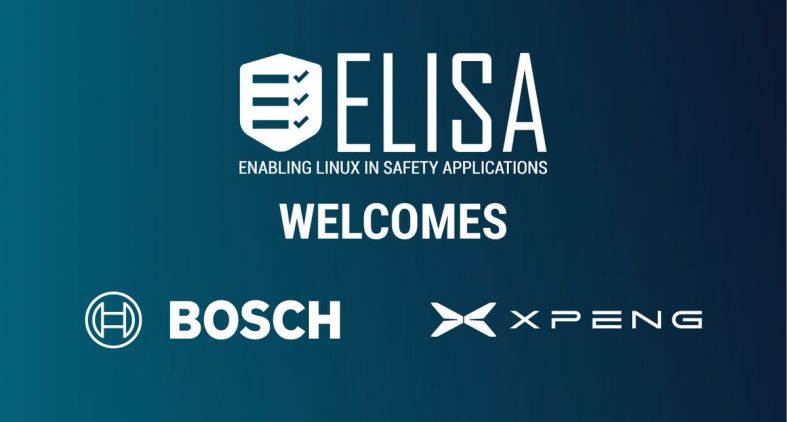Electric Automaker XPeng and Bosch Join the ‘ELISA Project' to Promote the Use of Linux in Safety-Critical Automotive Applications
【Summary】Electric automaker and Tesla rival XPeng, along with leading automotive component supplier Bosch, have announce they have joined the ELISA Project to promote the use of the Linux open-source software in critical automotive safety applications of electric and connected vehicles. The ELISA Project was launched in Feb 2019 to create a shared set of tools and processes to help companies build and certify Linux-based, safety-critical applications.

Electric automaker and Tesla rival XPeng, along with leading automotive component supplier Bosch, have announce they have joined the ELISA Project to promote the use of the Linux open-source software in critical automotive safety applications of electric and connected vehicles.
Linux is one of the most widely used open source software platforms in the auto industry. But its use of Linux spans nearly all major industries.
The benefit of using an open software platform such as Linux is it enables faster time to market for new features. All of the open source code has been thoroughly tested by the development community and is free to use as needed by developers and automakers.
Sharing an open software platform also allows for code reuse. Using Linux, developers can build once and have a product that can work for multiple OEMs.
The ELISA Project is an abbreviation of "Enabling Linux in Safety Applications". It's hosted by the non-profit Linux Foundation, which is a technology consortium headquartered in San Francisco.
The ELISA Project was launched in Feb 2019 to create a shared set of tools and processes to help companies build and certify Linux-based safety-critical applications of systems where any failure could result in loss of human life.
ELISA works with the Linux kernel and various safety communities on the best ways to incorporate Linux in safety-critical systems, such as advanced driver assist systems (ADAS) and autonomous driving functions.
Current ELISA Project members include major companies such as Arm, Boeing, Elektrobit, Huawei Technologies, Intel Corp,Toyota, NVIDIA, Automotive Grade Linux and others.
Automotive Grade Linux is a collaborative open source project that is bringing together automakers, suppliers and technology companies to accelerate the development and adoption of a fully open software stack for connected vehicles.
ELISA is open to everyone, allowing anyone to develop and contribute code. Developers can also get elected to the project's Technical Steering Committee to provide leadership and guide the technical direction of the project.

XPeng's Embedded Systems General Manager Yu Peng said the automaker joined ELISA in order to improve the functional safety and stability of Linux-based system software. Peng said the ELISA Project will help the automaker make its connected vehicle systems safer and more reliable.
"We are a technology company at heart. By addressing the needs of our customers with our expertise, we can solve the complicated questions in unchartered territory," said Peng. "We recognize the crucial and diverse role mobility plays in people's lives, and aspire to expand future mobility through intelligent revolution, from the road to the air."
XPeng's electric vehicles are highly advanced. But its still not clear how the company will integrate any Linux-based systems into its vehicles in the future.
However a year ago, Xpeng unveiled its flagship G9 SUV. It was the automaker's first production model to incorporate XPeng's new X-EEA 3.0 electronic and electrical architecture.
The X-EEA 3.0 architecture includes a centralized supercomputing platform and local control modules. At the software level, the G9's software suite has been structured in layers, which includes a system software platform, foundation software platform and intelligent application platform. The individual software layers allow for faster development and iteration of vehicle functions, such as advanced driver assistance and voice control.
The G9 was also China's first EV to implement a Gigabit Ethernet communications architecture, supporting multiple communication protocols, allowing vehicles to transmit and receive data much faster. The faster data transfers support the G9's advanced driver assistance, smart vehicle systems. But it also allows for faster over-the-air (OTA) firmware updates.
The G9's OTA firmware upgrade can be completed in under 30 minutes without interrupting the vehicle operation and driving function. The systems can synchronously upgrade multiple domain controllers in the vehicle. Once the G9 is restarted, all of the updates are fully implemented.
Bosch is one of the world's leading automotive suppliers. The company has expertise in electrical/electronic architecture of large integrated systems, real-time software, IoT applications and automotive hardware.
Bosch aims to take a leading position in the software-defined vehicles of the future. In 2020, the company established a new "Cross-Domain Computing Solutions" division for application-specific vehicle software and hardware for driver assistance systems as well as vehicle infotainment systems.
Bosch supplies automakers with roughly 200 million control units running its own software each year. As software-based vehicles become more like rolling smartphones, Bosch expects double-digit annual growth through 2030.
Bosch's middleware offers functional safety, real-time behavior, and reliability under automotive requirements that's combined with a high level of cyber-security. The company says its vast automotive experience and formal membership in ELISA fits well within the project goals.
"Due to Bosch's existing expertise in Linux and functional safety, the formal membership of Bosch within the ELISA project is a logical and consequent step," said Philipp Ahmann, Business Development Manager - Embedded Open Source, Cross-Domain Computing Solutions at Robert Bosch GmbH.
Automaker General Motors is also using Linux to power its next generation vehicle infotainment systems. In Nov 2021, the automaker announced its new end-to-end vehicle software platform called "Ultifi" that will underpin its future vehicles. Ultifi is built on Linux.
The platform was designed entirely in-house and will allow GM and its customers the ability to add new vehicle features and functions and personalization options, so customers can make their vehicles an extension of their digital lives.
With the Ultifi software platform, future GM customers will be able to subscribe to or unlock new vehicle features, such as the Supercruise automated driving feature or valet parking feature. These types of service can either be offered as a monthly subscription or as a one-time purchase.
Another possible use of the Linux-based Ultifi software platform is to unlock settings to increase vehicle performance, such as increasing the available battery power in an electric car.
Although GM's Ultifi is an in-house developed platform, the automaker will open it to authorized third-party developers in order to create software for future GM vehicles.
Building Ultifi on Linux open source software allows GM to authorize third-party developers to innovate on behalf of its customers. GM says the Ultifi software platform will open up an entire new ecosystem of software-based add-ons for future GM vehicles.
Toyota was one of the first automakers to adopt an Automotive Grade Linux (AGL) based system in the U.S. In May 2017, Toyota announced it was adopting the AGL platform for the next-generation infotainment system in the 2018 Camry sedan.
Around 75% of the AGL platform consists of a base layer. From there, automakers and suppliers can customize the platform with unique features, services and OEM branding to meet the needs of their customers.
The Linux Foundation was founded in 2000 after a merger between Open Source Development Labs and the Free Standards Group. The goal of the consortium is to promote commercial adoption of LINUX across industries. The foundation and its work is supported by more than 3,000 global members.
The ELISA Project will be represented at the Open Source Summit in Japan on Dec 5-6. Kate Stewart, Vice President of Dependable Embedded Systems at The Linux Foundation, will give a keynote address centered around the evolution of open source software and how it can benefit industries.
-


Ford is Testing a New Robotic Charging Station to Assist Drivers of EVs With Disabilities
-


Ford Raises the Prices of the F-150 Lightning Electric Pickup Due to Rising Raw Material Costs
-


The BMW 7-Series to Feature HD Live Maps From HERE Technologies for Hands-Free Highway Driving in North America at Speeds up to 80 MPH
-


AutoX to Use the 'Eyeonic Vision Sensor' from California-based SiLC Technologies for its Robotaxi Fleet in China
-


LG Develops ‘Invisible’ Speaker Sound Technology That Could Revolutionize In-Vehicle Audio
-


Researchers at South Korea’s Chung-Ang University Develop a ‘Meta-Reinforcement’ Machine Learning Algorithm for Traffic Lights to Improve Vehicle Throughput
-


Zeekr’s New 009 Electric Passenger Van is the World’s First EV to Feature CATL’s Advanced ‘Qilin’ Battery With a Range of 510 Miles
-


Redwood Materials is Building an Electric Vehicle Battery Recycling Facility in South Carolina
- Toyota to Collaborate With Texas-based Utility Provider Oncor to Accelerate a Vehicle-to-Grid EV Charging Ecosystem
- GM's Rebate of up to $6,000 on the Bolt EV and EUV Has a Big Stipulation
- Nexar Releases its ‘Driver Behavioral Map Data’ That Can Help Autonomous Vehicles Operate More Like Human Drivers
- Audi Rebrands its Premium Car Rental Service to ‘Audi on demand’
- LiDAR developer Luminar Technologies Hires Ex Apple, Tesla and Nvidia Execs as it Prepares for Growth
- Qualcomm and its Industry Partners Demonstrate C-V2X Technology in Georgia That Ensures School Buses and Fire Trucks Never Get Stuck at Red Lights
- Tesla’s Battery Supplier Panasonic is Working on New EV Battery Technology That Can Boost Range by 20%
- Volvo is Building a New EV Service and Training Facility at its U.S. Headquarters in New Jersey To Fast Track its Electrification Plans
- Ralph Nader Calls for NHTSA to Remove Tesla Full Self-Driving
- Lucid Group Hires Key Executives that Formerly Worked for Mercedes-Benz and Tesla as it Prepares for Global Expansion and Production Ramp Up











 About Us
About Us Contact Us
Contact Us Careers
Careers